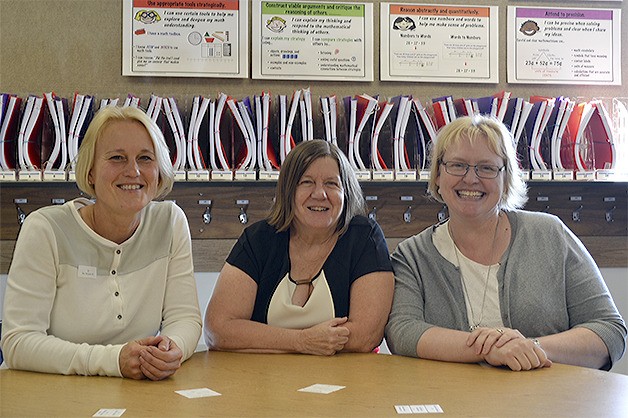MARYSVILLE – Sunnyside Elementary is looking at the sunny side of life after receiving some of the best state test scores in the Marysville School District.
But that’s quite a contrast from last spring, when students took the tests.
“Students were crying,” Betsy Guerra said, adding the stress for the kids in taking the test was one of the reasons she decided to retire four years earlier than planned.
The 8-year-old, third-graders, like all the students, took the tests online using Chromebooks. One of the frustrations was using the spellcheck function. On one essay, a student wanted to write “In conclusion,” but the computer changed it to “concubine.”
Guerra said even though she isn’t a fan of state tests, she and fellow third-grade teachers Karen Benjamin and Krissy Thorvilson did their best to make sure their students were successful.
“We wanted to give our kids the best shot as we could at it,” Guerra said. “It’s an incredibly ambitious test.”
For example, in writing, students had to plan, draft and compose three different multi-graph essays: narrative, formative and opinion.
She said they spent “hours and hours and hours” trying to find a math curriculum that matched the state standards. They did, and “because of us” the entire district has switched to that one, Guerra said.
Students in grades 6 to 12 will get their own Chromebooks this year, but in the grade schools there are about 90 that are shared. The three teachers said they tried to sign up for them as often as they could so their students would know how to navigate them come test time.
The three said one reason their students were so successful in the test is because they all showed concern for their students.
“They couldn’t fall through the cracks,” Benjamin said. “All of the third-graders were our kids. We believed in and cared for them.”
Guerra added all three have master’s degrees and at least 17 years of experience. But the class was not filled with high achievers. They had special education, English language learner, low achievers and behavioral problem kids. But they scored 67 percent in English/Language Arts and 68 percent in math. Those scores are about 20 percent better than the other district schools.
The teachers also worked to make sure their students understood the vocabulary and terminology that would be used on the test.
“No one said, ‘I’ve never seen this before,’ or ‘I don’t know what this means’,” Guerra said.
Another challenge is the test is given right after spring break.
“We had to try to cram it all in,” Benjamin said of nine months worth of content needing to be learned in seven months.
Guerra said she loves writing and wanted to instill that same love in her students but all of the testing makes it impossible. She mentioned more than a dozen different types of tests their students take each year.
She said while their students tested well, it “came at a huge cost.” They had to narrow the curriculum so students had fewer lessons in art and science than in previous years.
“Secondly, testing and test preparation have a disproportionate cost in both time and money that could be better be used in instruction,” she added.
Plus, “parents reported that children were stressed and anxious,” Guerra concluded.
The trio did have some tips for other teachers on how they could improve their students scores.
1. Spend time on the computer writing.
2. Spend time on the computer doing math.
3. Collaborate and split the curriculum. Guerra focused on writing, Benjamin on math and Thorvilson on reading. Students traveled to the different classrooms.
4. Teach the lesson three times.
5. Find a curriculum and match it to Common Core standards. The three had to come up with their own curriculum because the standards were rolled out before the state and district decided on curriculums.
6. Go on the OSPI website and take the interim tests.



